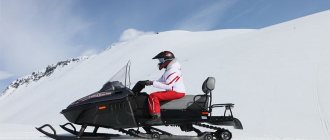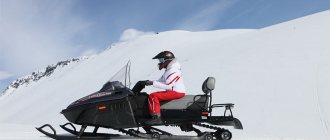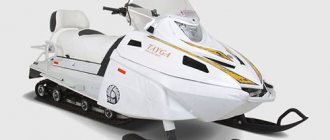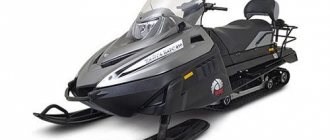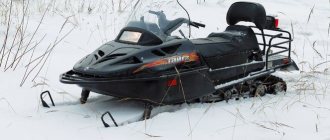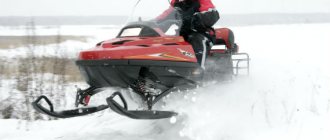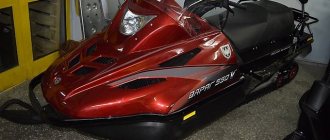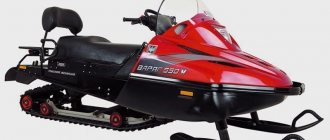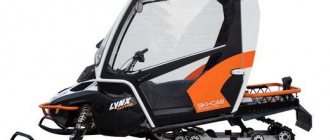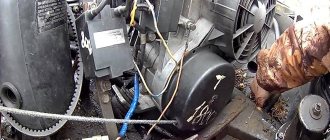Currently, snowmobiles are becoming the most popular vehicles among hunters, fishermen and residents of the far north. This is explained by the fact that this type of equipment is practical and unpretentious; moreover, it can travel where all-terrain vehicles, due to their weight and overall dimensions, are not capable. There are quite a large number of different snowmobiles on the market, both imported and domestic. From the low-cost transport segment, the Taiga Varyag 500 snowmobile model from Rybinsk should be highlighted. This snowmobile is a new generation of its model range and differs from previous models in its lighter weight by 15 kilograms.
To present the machine, the Kola Peninsula was chosen, which is rich in everything necessary for testing such equipment, namely mountain peaks, avalanches, deep snow mass, rivers and streams, wet slopes, as well as muddy forest foothills. The entire run lasted for three days and during all this time this snowmobile performed excellently. The car really has high maneuverability, reliability and convenience. The snowmobile's steering wheel is high, which allows you to perform various maneuvers in a standing position. There is also a high windshield, heated steering wheel and gas trigger, and a double seat.
But in addition to all the advantages of this snowmobile, there is one minor drawback, namely the weak fastening of the hood and windshield. Apart from this, no weaknesses were identified in the machines.
Which country produces snowmobiles?
A few words about it belongs to one of the most successful lines of domestic production. In turn, the company is a recognized leader in the design and production of all-terrain vehicles in the mid-price segment. The RM machine-building plant is located in the suburbs of Rybinsk, Yaroslavl region.
The manufacturer specializes in the development, design, and production of snowmobiles, ATVs, as well as spare parts and components for them. At each stage there is constant quality control.
About the Taiga line
The first Tayga snowmobile rolled off the production line in 1997 and almost immediately gained popularity among lovers of active winter recreation. Since then, several lines of all-terrain vehicles have been released, which, in turn, had a number of modifications within them. Among them there was even a children's snowbike - "Lynx", which, in accordance with the nominal characteristics, could withstand a weight of up to 40 kg. A number of modifications of the powerful Patrol snowmobile have been adopted by the military services of our country.
The Varyag 500 model was first presented in 2010. It belongs to the universal type and has the characteristics of a utilitarian all-terrain vehicle. The car is used for economic purposes for traveling through the snow to the store, walking livestock. Due to its lightness and mobility, it is well suited for this. Hunters and fishermen often choose this model because of its relatively low cost.
Advantages and disadvantages
Like any technique, the above model has its pros and cons:
pros
— An excellently balanced frame, thanks to the correct weight distribution, allows you to enjoy driving on any type of terrain.
— Excellent ratio of such basic characteristics as power/weight
— Ease of maintenance and reliability of body panels
— Spacious fuel tank
Minuses
— Hard seat that is not intended for long trips
— Poor response to sudden changes in speed using the handle
— Frequently dirty air filter
— No backrest for the passenger in the basic configuration
Modifications
The Taiga Varyag 500 snowmobile is a modification of another machine produced by RM - the Varyag 550. While working on this model, engineers were looking for new ways to improve the basic version, which would reduce the cost of production without losing quality at the same time.
Main differences
The new all-terrain vehicle turned out to be 15 kilograms lighter than the prototype. As a result, engineers had to abandon the electric starter in favor of a manual one, and also lighten the design of the front bumper. At the same time, the car did not lose any strength. But the most important and successful decision was the replacement of the 553-ml engine with an analogue with a smaller volume - 407 cubic meters.
Another modification of the model is a change in the center of mass. The 500th model received a low center of gravity, which was now located next to the drive axle of the snowmobile. This made it possible to achieve good vehicle stability when moving along steep slopes.
Materials and technologies
In the manufacture of a snowmobile, only high-quality plastic is used, which has an impact-absorbing property, which allows not only to increase passive safety when driving a vehicle, but also to preserve its aesthetic appearance for a long time. Reliable front skis are able to withstand high peak overloads, which allows you to increase the maneuverability of even the basic model. The streamlined shapes of the snowmobile are made in such a way that flying snow does not clog the viewing glass and, accordingly, does not cause discomfort to the driver and passenger. The footrests have a special shape that completely protects the feet.
Operating manual
Since the Varyag 500/550 and Ataka 551 II models have similar technical characteristics, they also have a common operating manual. The document contains detailed information on preparation for work, maintenance of all components, as well as the procedure for seasonal preservation and proper storage of the machine.
When operating a snowmobile, a number of requirements must be met:
- Before installing a battery that has been stored for a long time at sub-zero temperatures, it is necessary to keep it indoors for several hours.
- When starting the engine, you must slowly pull the start handle towards you until resistance appears.
- Do not fill the fuel tank to capacity. Otherwise, excess gasoline may spill out.
- Do not change gears until the snowmobile has come to a complete stop. In this case, the motor should be running.
- You can start the engine only after thoroughly checking the serviceability of all components of the snowmobile.
In addition, it is necessary to conduct a thorough inspection of the equipment, checking the serviceability of all important elements. The instruction manual provides detailed instructions on how to do this.
Break-in recommendations
Running in new equipment is an important part of its operation. Its performance and reliability in the future depends on the mode in which the snowbike operates at first, until the engine travels 300-350 km.
In this regard, the manufacturer recommends observing certain conditions during break-in:
- ride without passengers;
- choose compacted sections of the road;
- do not travel at temperatures above minus three degrees;
- monitor the engine temperature and the reliability of the fastenings;
- after 150 km, check the tension of the fan belt and tracks;
- before stopping the engine, it is necessary to keep it idling for half a minute;
- prepare a fuel mixture of gasoline and oil in a ratio of 50:1.
The manufacturer also does not recommend teaching other people how to ride an all-terrain vehicle, as this may lead to undesirable consequences.
Technique for adjusting ski toe
- check that the steering wheel is straight
- loosen locknuts 15 of both steering rods 20, 27
- by rotating the steering rods, ensure that when the skis are positioned “straight forward”, distance A in the front of the skis is greater than distance B in the rear of the skis by 10 mm (A – B = 10 mm)
- tighten the tie rod locknuts.
Taiga tormented me, only I unlocked the gearbox, now it started working on either 1 or 2 cylinders, i.e. at idle it doesn’t work normally at all, but when driving it runs on 1 cylinder, then on two, and so on in a cycle, then 1 then 2, with the throttle equally pressed, TAIGA500 1 carb. It was the same with mine, I came home on a rope. Knowledgeable people from the site helped. The hall sensor was replaced and the order was correct.
Specifications
The Taiga 500 snowmobile has a classic design and average technical characteristics. “Varyag” received two guide skis and a Wide Track track. The motorcycle-type handlebar is set high, which makes it possible to comfortably pilot the car while standing.
Options and equipment
Optionally, the snowmobile has a spacious luggage compartment, which is located under the two-level seat. The reinforced towbar allows you to tow cargo sleds weighing up to 250 kilograms.
In addition, the standard package includes:
- passenger seat (without backrest);
- heating system for gas trigger and steering handles;
- windshield.
Daniila Rukin
Snowmobile specialist "Buran". I go fishing in my free time.
Ask a Question
The manufacturer provides a three-year warranty from the factory, which, however, does not apply to all parts of the snowmobile.
Dimensions and weight
“Varyag 500” is considered the lightest snowbike from the family of special equipment. The weight of an unloaded all-terrain vehicle without a pilot, passenger and cargo is 260 kg. In this case, the machine has the following overall dimensions (in meters):
| Length (with skis) | 2,99 |
| Width | 1,05 |
| Height (with glass) | 1,38 |
The deviation in size is 3 cm in one direction and the other.
Suspension
One of the features of this unit is the telescopic front suspension. Its stroke is 10.5 centimeters. Additionally, the design is equipped with a monotube shock absorber.
The rear suspension is the same as on other modern models of snow all-terrain vehicles produced by Russian Mechanics, namely, skid-mounted. Its stroke is 19 centimeters. Among other things, the machine has a pipe-type hydropneumatic shock absorber at the rear. Thanks to this, as well as the mounting springs, the rear suspension mechanism has a good supply of energy and contributes to a smooth ride.
Chassis
Transmission
The described snowbike has a two-stage transmission. A variator is used as a transmitting device. The box has four gears:
- reverse;
- neutral;
- reduced;
- increased.
Brake system
The snowmobile is equipped with a mechanical hydraulic disc brake. The design is standard for all models of the Taiga series.
Propulsion parameters
The role of the propulsion device is performed by the Composit track mechanism with front-mounted drive sprockets.
Tape dimensions:
| Full Length | 3.937 m |
| Blade width | 50 cm |
| Height of lugs | 2.2 cm |
| Distance between skis | 90 cm |
The length of the track support surface is 50.8 cm.
Electrical equipment
The standard equipment of the model includes a manual starting system, which has a programmable capacitive ignition - DUCATI CDI. Thanks to it, the engine runs equally smoothly even under heavy loads.
Daniila Rukin
Snowmobile specialist "Buran". I go fishing in my free time.
Ask a Question
Additional comfort while driving is provided by a powerful halogen front lamp with a power of 55/60 watts and optional heated steering grips. In addition, the model has an electronic reverse, speedometer and odometer.
Engine
The Varyag 500 is powered by a two-stroke carbureted proprietary (RM) engine with two cylinders. Their total volume is 497 cubic centimeters. The role of the main battery of the power unit is played by the Mikuni carburetor fuel system.
Main parameters of the motor:
| Model | RMZ-500 |
| Power | 43 horsepower |
| Carburetor type | float |
| Lubrication system | joint |
| Cylinder diameter | 7.2 cm |
| Piston stroke | 6.1 cm |
| Cooling system | air |
In addition, the all-terrain vehicle has a muffler with a resonator at the outlet and an intake noise muffler at the inlet.
Performance characteristics
Maximum flow
Despite the fact that the snowmobile belongs to the class of semi-professional light special equipment, it is quite “gluttonous”. Owners note that in some cases, gasoline consumption can reach up to 30 liters per 100 kilometers, while the manufacturer claims a different figure - 22 liters. Of course, the amount of fuel consumed by the engine depends on many factors. These include driving style, driving speed, type of terrain traversed and the condition of the main undercarriages.
Fuel tank capacity and engine lubrication
A standard tank holds 40 liters of fuel. For refueling, it is advisable to choose gasoline with an octane number of at least 92. Since the power unit has a mixed lubrication system, engine oil should be added to the fuel, since there is no separate container for oil. The manufacturer recommends preparing the mixture in a ratio of 40:1. Thus, it is recommended to take one liter of oil for two-stroke engines for one full tank.
Speed
In accordance with the design features of the motor, the snowmobile is capable of reaching speeds of up to 80 km/h on a flat surface. Some owners note that they were able to overcome this mark while driving on ice. At the same time, the pilot feels most comfortable when accelerating to 60-65 km per hour.
Ergonomic properties
Like most snowmobiles of the Varyag family, the 500 model is equipped with a spacious luggage compartment, which is harmoniously placed under the rear seat. The entire trunk volume is divided for ease of use. The developers used an additional reinforcement system, which significantly reduced the overall weight of the snowmobile. Thus, having a lower curb weight, a snowmobile in terms of speed characteristics and cross-country ability, on the highway is often not inferior to similar models with more powerful engines. The electrical circuit of the Taiga 500 snowmobile is designed to absorb a minimum amount of battery energy.
Owner reviews
The Taiga Varyag 500 snowmobile model has mixed reviews from owners regarding fuel consumption. Some say that the SUV consumes too much fuel, others note that a full tank lasts for a long time. Many praise the car for its affordable price, but note a lack of comfort.
Eugene
“I purchased this model in 2013. I've been riding it for over five years now and I love it. As for consumption, it takes me 19 liters for rolled snow, and about 25 liters for freshly fallen snow. Although all two-stroke engines are voracious"
Danil
“I bought this “miracle of technology” in 2015. I was simply shocked when I discovered that the car consumes 40 liters per hundred kilometers. I contacted the service center and it turned out that the corrector cable was faulty. After replacing the part, the snowmobile began to consume 24-26 liters. Still, it seems to me that this is too much, despite the fact that the manufacturer claims 22 liters.”
Sergey
Filippovo: “I took the Taiga 500 two years ago. During this time the car never broke down. Used strictly for economic purposes, for walking livestock on the farm. I had to change the spark plugs from time to time, because when driving at low speeds, carbon deposits appeared on them. My device consumed about 18-19 liters per 100 km.”
Long-range test - long-term test of the Taiga Varyag 500 snowmobile
We were able to carve out a few truly winter days in our failed winter and drove almost a thousand kilometers behind the wheel of our Varyag. As part of the run organized by Russian Mechanics, we walked the path from Rybinsk to Veliky Ustyug
Utilitarian snowmobile/2014/265 kg/503 cm3/43 hp/199,900 rub.
Mileage at the time of publication - 1100 km
We did it! We were able to carve out a few truly winter days in our failed winter and drove almost a thousand kilometers behind the wheel of our Varyag. As part of the race organized by Russian Mechanics, we walked the path from Rybinsk to Veliky Ustyug.
We will tell you about the trip itself, which, it should be noted, is unprecedented in the practice of factory test drives a little later, when photos and video materials are ready, but now let’s talk about how our test subject performed during the run, and in general, what good and bad happened to "Varyag" for the month that has passed since the previous report.
Let's start with the good stuff. At the very beginning of the test, we wrote that we planned to retrofit the snowmobile to the state of a comfortable machine. “Varyag 500” is a basic model, deprived of many “amenities” for the sake of cheaper prices. However, no one forbids “finishing with a file” and “making it to your liking.”
Fortunately, the base of the device is completely identical to the more advanced model “Taiga 550 V”; there was no need to reinvent the wheel. We installed "sports" combs on the driver's footpegs. It seems like a small thing, but how much easier it has become to “live”! The eternal problem of feet slipping during active driving has gone into oblivion! It is clear that all foreign cars, and even more expensive RM models, are equipped with this option in the database, but the “five hundred” did not have them. “Teeth” can be purchased from any dealer; they are installed in a few minutes using a couple of blind rivets.
The second long-awaited acquisition is a passenger backrest. The new model part is attached not to the base of the seat, as before, but to the trunk frame. Since there are already holes in the trunk (the unit is unified with the older model), attaching the backrest with four bolts is not difficult. It's a matter of five minutes. But the passenger immediately gains comfort, safety and tranquility. Now you don’t need to frantically grab onto the pilot so as not to fall “overboard” during acceleration or on potholes. Naturally, the back is equipped with comfortable handles to hold on to. It would be logical to install passenger steps, but for now there is no particular need for them. The passenger already has somewhere to put his feet, but the pilot often gets in the way when he has to move back and forth on the footrests.
It is quite common practice for snowmobilers to ride with a backpack. Thermos, snack, spare gloves or mask. in general, a minimal gentleman's set is always with you. If a passenger appears on a snowmobile, the backpack “moves” onto his back so that it does not interfere between the riders. We used to travel like this, but the “grown” back does not fit well with the backpack. Therefore, we installed a trunk in the trunk.
The case is made of frost-resistant and waterproof material. It fits perfectly into the dimensions of the trunk, since it was created specifically for the Taiga series. The case is attached to the trunk frame with straps, but God protects those who are on the safe side, and just in case, we secured the case with a Hungarian rubber band - a generally accepted practice. The bag has several compartments, is adjustable in volume and holds an incredible amount of junk. Even a portable refrigerator is included. By the way, a very useful option if you are going on a picnic. In it, like in a thermos, sausage, pate, cheese and other products, not to mention liquids, do not turn into pieces of ice that have to be chewed or warmed up by the fire and on the exhaust pipe. In addition, we finally installed a new windshield to replace the one that was broken a month and a half ago. After these simple modifications, the snowmobile turned out to be fully equipped for long trips.
"Polaris Widetrack"
This model is considered the most popular among utilitarian representatives. The popularity is due to the reliability of the design and high build quality. Among the advantages, they also note the reliable start of the motor, which is capable of operating efficiently at critically low temperatures. The two-stroke “engine” guarantees the required thrust and does not overheat at high speeds, since the liquid cooling jacket is functioning. Other advantages include ease of maintenance and operation of most components.
The engine power is 85 “horses”, two cylinders are equipped with a separate carburetor. The lubrication system is of a separate configuration. Good control is ensured by the front wishbone suspension, which behaves well even at a speed of 100 km/h. The rear analogue is a torsion shock absorber.
Parameters and dimensions of the snowmobile:
- engine volume – 488 “cubes”;
- transmission – variator with low gear and reverse;
- towed trailer weight – 300 kg;
- dry weight – 278 kg;
- length/width/height – 3.25/1.10/1.29 m;
- caterpillar dimensions – 3.45/0.5 m.
RAS SUSPENSION
This type of suspension found its application on the REV chassis. The design of this suspension is based on double A-arms. The principle of operation of this suspension is as follows - the main part of the shock load falls directly on the spring and shock absorber and only a small part on the chassis itself. Typically, a snowmobile with a REV chassis has a pyramidal frame shape. Due to this, the design of the snowmobile is incredibly durable, capable of withstanding heavy loads and the movement of the snowmobile on the most extreme trails.
Video
About some of the machine's capabilities
The steering on the Varyag is located high, making driving the car much more convenient.
The handles are equipped with rubberized pads, which makes them ergonomic. If the snowmobile falls upside down, the heavy-duty glass will not break and will remain the same as before the impact. This was made possible thanks to the use of special polycarbonate fiber. In addition, the windshield provides the rider and passenger with reliable protection from oncoming gusts of wind and snow.
Traveling through deep forest thickets is also not scary for the Varyag. The blows of branches and trees will be absorbed by the glass and hood, and the snowmobile can easily overcome the most difficult irregularities thanks to the breaking heel on the rear suspension. This also helps ensure that when reversing, it will not get stuck in deep snow.
The luggage compartment of the car is spacious, and you can put up to 100 kg of hand luggage there. In addition, there is a place under the driver’s seat for some things and various tools. With a vehicle weight of only 280 kg, you can drag a load of over 200 kg behind you on a drag sleigh or sled, for which a tow bar is provided in the snowmobile. Well, if the need nevertheless arises to increase the space for luggage, no one bothers to install a comfortable and roomy chest. Fishing gear and hunting accessories can also be stored here.
